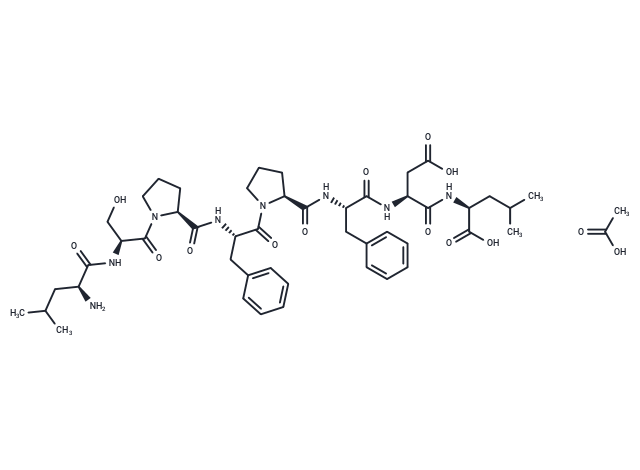Shopping Cart
- Remove All
 Your shopping cart is currently empty
Your shopping cart is currently empty

p2Ca acetate is a naturally processed peptide that derives from a ubiquitous enzyme, alpha-ketoglutarate dehydrogenase, and is recognized in association with the class I MHC protein, Ld, by a CTL clone (2C).

| Pack Size | Price | Availability | Quantity |
|---|---|---|---|
| 1 mg | $123 | In Stock | |
| 5 mg | $298 | In Stock | |
| 10 mg | $443 | In Stock | |
| 25 mg | $690 | In Stock | |
| 50 mg | $930 | In Stock | |
| 100 mg | $1,180 | In Stock | |
| 200 mg | $1,580 | In Stock |
| Description | p2Ca acetate is a naturally processed peptide that derives from a ubiquitous enzyme, alpha-ketoglutarate dehydrogenase, and is recognized in association with the class I MHC protein, Ld, by a CTL clone (2C). |
| In vitro | p2Ca and QL9 peptides assume distinct conformations when bind to Ld and, furthermore, demonstrate that there is flexibility in peptide binding within the MHC class I cleft. Ld antigenic peptide p2Ca (LSPFPFDL) is 8-mer that lack the proline at position 2 and thus use alternative amino-terminal anchors. The p2Ca octamer is identified as the ligand that is naturally processed and presented to the Ld-alloreactive T cell clone, 2C[1]. p2Ca, is immunodominant in allorecognition of the murine MHC class I molecule H-2Ld. The majority of Ld-alloreactive T-cell clones are specific for Ld-p2Ca and this immunodominance is not due to peptide cross-reactivity[2]. p2Ca is a ubiquitously expressed self-peptide. p2Ca is derived from the mouse mitochondrial enzyme α-ketoglutarate dehydrogenase. p2Ca is present in every tissue of BALB/c mice that has been examined, including the spleen and thymus. It is also expressed by mouse tumor cell lines such as the mastocytoma P815. CTL derived in vitro recognize specifically the p2Ca/L d complex and use Vβ8 regions predominantly. The cultured cells lyse target cells with lower levels of p2Ca than the levels used for induction. This result suggests that it may be possible to use peptides at high concentrations to elicit CTL that react with endogenous levels of a peptide/class I complex[3]. |
| In vivo | BALB/c mice, coinjected with a syngeneic BALB/c myeloma and exogenous p2Ca, are able to reject the tumor. The p2Ca/L d system may thus provide a model for evaluating the parameters for effective immunotherapy with tumor-associated peptides[3]. |
| Molecular Weight | 995.15 |
| Formula | C49H70N8O14 |
| Smiles | O=C([C@H]1N(CCC1)C([C@H](CO)NC([C@@H](N)CC(C)C)=O)=O)N[C@@H](CC2=CC=CC=C2)C(N3[C@@H](CCC3)C(N[C@H](C(N[C@@H](CC(O)=O)C(N[C@H](C(O)=O)CC(C)C)=O)=O)CC4=CC=CC=C4)=O)=O.CC(O)=O |
| Relative Density. | 1.31g/cm3 |
| Storage | keep away from moisture | Powder: -20°C for 3 years | In solvent: -80°C for 1 year | Shipping with blue ice. | ||||||||||||||||||||
| Solubility Information | DMSO: 10 mM, Sonication is recommended. | ||||||||||||||||||||
Solution Preparation Table | |||||||||||||||||||||
DMSO
| |||||||||||||||||||||

Copyright © 2015-2025 TargetMol Chemicals Inc. All Rights Reserved.